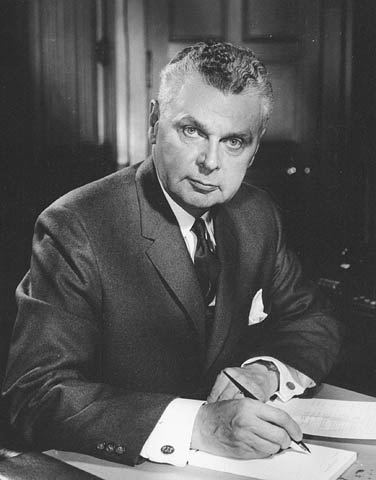June 18, 1962 1963 → 208 seats, 53.66% 48 seats, 33.40% 92 51 | Turnout 79.0% (0.4pp) 116 99 2,865,542 2,846,589 | |
 | ||
The Canadian federal election of 1962 was held on June 18, 1962 to elect members of the Canadian House of Commons of the 25th Parliament of Canada. When the election was called, Progressive Conservative (PC) Prime Minister John Diefenbaker had governed for four years with the then-largest majority in the House of Commons in Canadian history.
Contents
This election reduced the PCs to a tenuous minority government as a result of economic difficulties such as high unemployment and a slumping Canadian dollar, as well as unpopular decisions such as the cancellation of the Avro Arrow. Despite the Diefenbaker government's difficulties, the Liberal Party, led by Lester Pearson, was unable to make up enough ground in the election to defeat the government. For Social Credit, routed from the Commons just four years earlier, this election proved to be their most successful ever - they would never better the 30 seats won, losing seats in 1963 despite gaining a slightly better share of the vote.
Overview
During its term of office, the Diefenbaker government had introduced reforms to social programs, a Canadian Bill of Rights, and other changes. The Tories tried to defend the decline in the Canadian dollar by pointing out the benefits to the tourism industry, exports, manufacturing and farming, and employment. They denied that the devaluation affected the price of bread, beef, gasoline and fruit and vegetables, saying that these prices were either set in Canada or were influenced by other factors.
The Liberals campaigned under the slogan, "Take a stand for tomorrow", and attempted to portray the Diefenbaker government as "feeble", with a divided cabinet. The Liberals criticized the PCs for their "reckless mismanagement of finances", the slowdown in the Canadian economy, a lack of confidence in government policies, job losses, and a lower standard of living than in 1956. The Liberals also argued that the steep devaluation in the Canadian dollar was increasing the cost of living for Canadians.
The 1962 election was the first contested by the social democratic New Democratic Party, which had been formed from an alliance between the old Co-operative Commonwealth Federation (CCF) and the Canadian Labour Congress. The party chose longtime Premier of Saskatchewan Tommy Douglas as its first leader. The new party was able to recover ground lost by the CCF in the 1958 federal election, when it was nearly wiped out. It won almost 50% more votes than the CCF had ever managed, but it failed to achieve the major breakthrough that had been hoped for when the party was created.
The NDP was shut out in Saskatchewan, its political base, where Douglas failed to win his own seat. Douglas's campaign was hurt by chaos in Saskatchewan brought about by the introduction of Medicare and a resulting strike by the province's doctors. Douglas was forced to enter the House of Commons through a by-election in British Columbia. Despite the initial problems, medicare proved popular, spread throughout the country, and is considered the NDP's (and Douglas's) major contribution to the Canadian social fabric.
Social Credit returned to the House of Commons after being shut out in the 1958 election. While leader Robert N. Thompson and three other Socreds were elected in the party's traditional base in western Canada, the party's real success came in Quebec. Réal Caouette led the party's Quebec wing to victory in 26 ridings. Indeed, their win of 30 seats overall represented the party's greatest federal showing ever. They would never again equal, let alone surpass, that number - though the party gained its highest share of the vote in the 1963 election (1962 being its second-highest by a very close margin), it ended up losing 6 seats.
For the first time ever, the entire land mass of Canada was covered by federal electoral districts (the former Mackenzie River riding was expanded to cover the entire Northwest Territories), and Canadian Indians and Inuit could all vote for the first time.
National results
Voter turn-out was 79.0%.
Notes:
* Party did not nominate candidates in previous election.
x - less than 0.005% of the popular vote.
1 compared to Labor-Progressive Party results from previous election.
Results by province
xx - less than 0.05% of the popular vote
